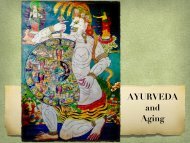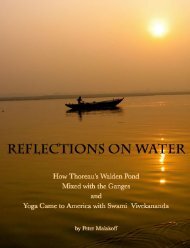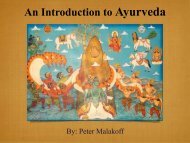How Thoreau's Walden Pond Mixed with the Ganges and Yoga Came to America with Swami Vivekananda
One early morning in 1846, during the coldest days of a New England winter, Henry David Thoreau looked out the window of his small cabin on Walden Pond and saw men cutting its ice into blocks. That ice was hauled by horse to a railroad that ran across the western edge of Walden Pond, packed into a boxcar, taken to Boston and loaded onto a clipper ship that sailed to Calcutta, India, arriving about four months later. Once there, that ice was purchased by grateful members of the East India Company. Thoreau had witnessed a small part of the global ice trade between New England and India that took place during the latter part of the nineteenth century. When Thoreau considered the ice trade, his vision sailed on metaphors far beyond the scope of business. The waters he imagined flowed both east and west and carried not just natural elements, but culture, religion and philosophy as well. He envisioned that after arriving in Calcutta, the New England ice of Walden Pond would eventually melt and run downhill where it would join with the sacred water of the Ganges. He wrote in Walden: "It appears that the sweltering inhabitants of Charleston and New Orleans, of Madras and Bombay and , drink at my well. In the morning I bathe my intellect in the stupendous and cosmogonal philosophy of the , since whose composition years of the gods have elapsed, and in comparison with which our modern world and its literature seem puny and trivial; and I doubt if that philosophy is not to be referred to a previous state of existence, so remote is its sublimity from our conceptions. I lay down the book [Bhagavad-Gita] and go to my well for water, and lo! there I meet the servant of the Bramin, priest of and and who still sits in his temple on the Ganges reading the , or dwells at the root of a tree with his crust and water jug. I meet his servant come to draw water for his master, and our buckets as it were grate together in the same well. The pure Walden water is mingled with the sacred water of the Ganges." This book tells the story of these waters . . .
One early morning in 1846, during the coldest days of a New England winter, Henry David Thoreau looked out the window of his small cabin on Walden Pond and saw men cutting its ice into blocks. That ice was hauled by horse to a railroad that ran across the western edge of Walden Pond, packed into a boxcar, taken to Boston and loaded onto a clipper ship that sailed to Calcutta, India, arriving about four months later. Once there, that ice was purchased by grateful members of the East India Company. Thoreau had witnessed a small part of the global ice trade between New England and India that took place during the latter part of the nineteenth century.
When Thoreau considered the ice trade, his vision sailed on metaphors far beyond the scope of business. The waters he imagined flowed both east and west and carried not just natural elements, but culture, religion and philosophy as well. He envisioned that after arriving in Calcutta, the New England ice of Walden Pond would eventually melt and run downhill where it would join with the sacred water of the Ganges. He wrote in Walden: "It appears that the sweltering inhabitants of Charleston and New Orleans, of Madras and Bombay and , drink at my well. In the morning I bathe my intellect in the stupendous and cosmogonal philosophy of the , since whose composition years of the gods have elapsed, and in comparison with which our modern world and its literature seem puny and trivial; and I doubt if that philosophy is not to be referred to a previous state of existence, so remote is its sublimity from our conceptions.
I lay down the book [Bhagavad-Gita] and go to my well for water, and lo! there I meet the servant of the Bramin, priest of and and who still sits in his temple on the Ganges reading the , or dwells at the root of a tree with his crust and water jug. I meet his servant come to draw water for his master, and our buckets as it were grate together in the same well. The pure Walden water is mingled with the sacred water of the Ganges."
This book tells the story of these waters . . .
You also want an ePaper? Increase the reach of your titles
YUMPU automatically turns print PDFs into web optimized ePapers that Google loves.
Vedic literature of India<br />
The Vedic Literature of India is a vast amount of texts. The main texts referred<br />
<strong>to</strong> were <strong>the</strong> Laws of Manu, The Upanishads <strong>and</strong> <strong>the</strong> Bhagavad-Gita. <strong>How</strong>ever below<br />
is a more complete accounting:<br />
“The wisdom <strong>and</strong> knowledge of <strong>the</strong> Aryans is contained in <strong>the</strong>ir sacred literature,<br />
collectively known as <strong>the</strong> Vedic literature.<br />
Early Vedic Literature:<br />
1. The Vedas are <strong>the</strong> oldest <strong>and</strong> <strong>the</strong> most sacred books of <strong>the</strong> Aryans, <strong>and</strong> are<br />
four in number: <strong>the</strong> Rigveda, <strong>the</strong> Samaveda, <strong>the</strong> Yajurveda <strong>and</strong> <strong>the</strong> Atharvaveda.<br />
2. The Brahmanas are <strong>the</strong> prose texts containing observations on <strong>the</strong> various<br />
sacrificial rites <strong>and</strong> ceremonies.<br />
3. The wisdom <strong>and</strong> knowledge of <strong>the</strong> Aryans is contained in <strong>the</strong>ir sacred literature,<br />
collectively known as <strong>the</strong> Vedic literature.<br />
4. Early Vedic Literature:<br />
5. 1. The Vedas are <strong>the</strong> oldest <strong>and</strong> <strong>the</strong> most sacred books of <strong>the</strong> Aryans, <strong>and</strong><br />
are four in number: <strong>the</strong> Rigveda, <strong>the</strong> Samaveda, <strong>the</strong> Yajurveda <strong>and</strong> <strong>the</strong> Atharvaveda.<br />
6. 2. The Brahmanas are <strong>the</strong> prose texts containing observations on <strong>the</strong> various<br />
sacrificial rites <strong>and</strong> ceremonies.<br />
7. 3. The Aranyakas, also known as <strong>the</strong> 'Forest Books', are <strong>the</strong> concluding portion<br />
of <strong>the</strong> Brahmanas <strong>and</strong> deal <strong>with</strong> mysticism <strong>and</strong> philosophy.<br />
8. 4. The Upanishads are <strong>the</strong> main source of Indian philosophy <strong>and</strong> have<br />
found an important place in <strong>the</strong> his<strong>to</strong>ry of world literature, having been translated<br />
in<strong>to</strong> various foreign languages like English, French, German <strong>and</strong> Persian.<br />
They are about 300 in number, <strong>the</strong> more prominent ones being Isa,<br />
Kena, Katha, Mundaka <strong>and</strong> Brihadranyaka.<br />
9. Later Vedic Literature<br />
10.1. The Sutras: They are a collection of <strong>the</strong> various new cus<strong>to</strong>ms developed<br />
<strong>with</strong> <strong>the</strong> passage of time <strong>and</strong> are divided in<strong>to</strong> three classes- Srauta-<br />
Sutras, Griha-Sutras <strong>and</strong> Dharma-Sutras.<br />
11.2. Vedangas <strong>and</strong> Upavedas : Vedangas are a part of Vedic texts <strong>and</strong> deal<br />
<strong>with</strong> religious practices, pronunciation, grammar, etymology (science of<br />
words), metro <strong>and</strong> astronomy. The Upavedas deal <strong>with</strong> subjects such as medicine,<br />
music, art <strong>and</strong> architecture <strong>and</strong> war.<br />
12.The important Upavedas are Ayurveda, G<strong>and</strong>harvaveda, Dhanurveda<br />
<strong>and</strong> Shilpaveda.<br />
13.3. Six Shastras: These are <strong>the</strong> six well-known schools of Hindu philosophy,<br />
known as Darshanas or Shastras. In <strong>the</strong>se, <strong>the</strong> ancient sages have tried <strong>to</strong><br />
give answers <strong>to</strong> certain difficult philosophical questions concerning God, soul,<br />
birth <strong>and</strong> death. These are Sankhya Shastra by Kapila, <strong>Yoga</strong> Shastra of Patanjali,<br />
Nyaya Shastra of Gautama, Vaisheshik Shastra of Kanad, Puna Mimansa<br />
of Jamini <strong>and</strong> Uttarra Mimansa of Vyasa.<br />
14.4. The Puranas: They are <strong>the</strong> ancient texts of Hindus <strong>and</strong> are 18 in number.<br />
15.5. The Epics: The Ramayana <strong>and</strong> <strong>the</strong> Mahabharata are <strong>the</strong> two great epics<br />
of Hindus, which throw an important light on <strong>the</strong> social, religious, economic<br />
<strong>and</strong> political life of <strong>the</strong> Vedic Age Aryans.<br />
16.6. Dharma Shastras: These are a very important source of information<br />
about <strong>the</strong> laws <strong>and</strong> judicial procedures of <strong>the</strong> Aryans. Manu Smriti is <strong>the</strong><br />
most important of <strong>the</strong> Dharma Shastras.”<br />
–Brief Notes on <strong>the</strong> Vedic Literature of India, by Bharti Preeti<br />
Related Glossary Terms<br />
Advaita Vedanta, Bhagavad-Gita, Brahmin pundit, Indologist, Mahabharata, Max Muller, Ramayana,<br />
Rig Veda, Sanatana Dharma, Upanishads, Vanaprastya, Vedas, <strong>Yoga</strong><br />
Index<br />
Find Term<br />
Section 6 - Introduction<br />
Chapter 1 - <strong>How</strong> <strong>Thoreau's</strong> <strong>Walden</strong> <strong>Pond</strong> <strong>Mixed</strong> <strong>with</strong> <strong>the</strong> <strong>Ganges</strong> <strong>and</strong> <strong>Yoga</strong> <strong>Came</strong> <strong>to</strong> <strong>America</strong> <strong>with</strong> <strong>Swami</strong> Vivekan<strong>and</strong>a<br />
Chapter 1 - <strong>How</strong> <strong>Thoreau's</strong> <strong>Walden</strong> <strong>Pond</strong> <strong>Mixed</strong> <strong>with</strong> <strong>the</strong> <strong>Ganges</strong> <strong>and</strong> <strong>Yoga</strong> <strong>Came</strong> <strong>to</strong> <strong>America</strong> <strong>with</strong> <strong>Swami</strong> Vivekan<strong>and</strong>a


















